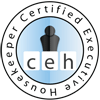Manufacturers of vinyl tile and sheet flooring apply a clear, tough acrylic, vinyl or urethane sealer that helps keep the surface durable. They can remain true no-wax surfaces for many years, but only under the best of conditions — no shoes, no kids, no big dogs and little foot traffic. That’s not likely in the kitchen, where many no-wax floors have been installed because of their durability.
Like all other floors, sweep vinyl floors regularly to remove dirt, grit, sand and other debris that will scratch and dull the finish. If you’ve used a floor finish, mop with water to which you’ve added a few drops of hand dishwashing liquid, then rinse with clean water. Ammonia or other harsh cleaning solutions are likely to remove some of the polish each time you use them, shortening the life of the floor finish.
The sealer will become scratched and dull after a few years of typical foot traffic. Applying a floor polish will restore a uniform shine, but only after the vinyl floor has been thoroughly cleaned and rinsed. Otherwise, you’ll just seal in stubborn dirt and/or cleaner residue under the floor finish, and the residue will degrade the appearance and longevity of the polish.
Old-style floor waxes that require buffing are a lot of work, particularly on large floors. For ease of application, choose a non-buffable wax such as Top Gloss, or a clear acrylic floor polish such as Duraplus, Enhance, Future, Glaze N Seal and other brand names.
Don’t place floor mats with no-slip backing on a vinyl floor for long periods. Chemicals used in this safety feature leach out and can yellow vinyl flooring permanently. Permanent yellowing can also occur where vinyl floors are repeatedly exposed to the ultraviolet rays in bright sunshine.
Vinyl flooring can be vulnerable to rust spotting in areas with hard water and when drops and splashes are allowed to dry on the floor. Remove rust spots with a 5-percent solution of oxalic acid, which is sold as a powder in both hardware and marine-supply stores. Read and follow all label instructions and warnings for safety and best results. Oxalic acid is poisonous, so store it well away from small children or pets. It’s also a skin and eye irritant, so protect yourself before use by wearing gloves, eye protection, long pants and long sleeves.
Oxalic acid works well in removing rust stains, but not quickly. Apply oxalic acid solution with a sponge or cloth to stains and allow it to work for at least five minutes. Rinse the spot well. A quick spray of an alkaline, all-purpose household cleaner will help neutralize the acid while rinsing. Repeat the treatment if necessary.
References:
Don Aslett, The Cleaning Encyclopedia: Your A to Z Illustrated Guide to Cleaning Like the Pros
Jeff Bredenberg, editor, in Clean It Fast, Clean It Right: The Ultimate Guide to Making Everything You Own Sparkle & Shine









